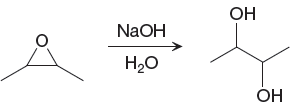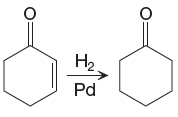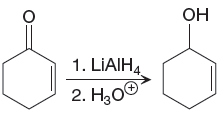
Concept explainers
(a)
Interpretation:
The differences in the IR spectra of the reactant and product that would enable you to tell that the given reaction has taken place are to be determined.
Concept introduction:
The frequencies of the stretching vibrations are estimated from the type of bond and the frequency range given for that bond. Also, the frequency range for the given type of bond is identified by the
Answer to Problem 15.41P
An OH stretch with stretching frequency
Explanation of Solution
The given reaction is

In the above reaction, the OH group, that is the alcohol functional group, is present in the reactant, and C=C bond of
The differences in the IR spectra that would enable to tell that the given reaction has taken place are determined on the basis of bonds and the functional groups present in the reactant and the product.
(b)
Interpretation:
The differences in the IR spectra of the reactant and product that would enable you to tell that the given reaction has taken place are to be determined.
Concept introduction:
The frequencies of the stretching vibrations are estimated from the type of bond and the frequency range given for that bond. Also, frequency range for the given type of bond is identified by the functional group to which that bond resembles in the molecule.
Answer to Problem 15.41P
A very broad OH stretch having stretching frequency
Explanation of Solution
The given reaction is

The
The differences in the IR spectra that would enable to tell that the given reaction has taken place are determined on the basis of bonds and the functional groups present in the reactant and the product.
(c)
Interpretation:
The differences in the IR spectra of the reactant and product that would enable you to tell that the given reaction has taken place are to be determined.
Concept introduction:
The frequencies of the stretching vibrations are estimated from the type of bond and the frequency range given for that bond. Also, frequency range for the given type of bond is identified by the functional group to which that bond resembles in the molecule.
Answer to Problem 15.41P
Two
Explanation of Solution
The given reaction is,

Two
The differences in the IR spectra that would enable to tell that the given reaction has taken place are determined on the basis of bonds and the functional groups present in the reactant and the product.
(d)
Interpretation:
The differences in the IR spectra of the reactant and product that would enable you to tell that the given reaction has taken place are to be determined.
Concept introduction:
The frequencies of the stretching vibrations are estimated from the type of bond and the frequency range given for that bond. Also, frequency range for the given type of bond is identified by the functional group to which that bond resembles in the molecule.
Answer to Problem 15.41P
The single N-H band having stretching frequency
Explanation of Solution
The given reaction is

The single N-H band having stretching frequency
The differences in the IR spectra that would enable to tell that the given reaction has taken place are determined on the basis of bonds and the functional groups present in the reactant and the product.
(e)
Interpretation:
The differences in the IR spectra of the reactant and product that would enable you to tell that the given reaction has taken place are to be determined.
Concept introduction:
The frequencies of the stretching vibrations are estimated from the type of bond and the frequency range given for that bond. Also, frequency range for the given type of bond is identified by the functional group to which that bond resembles in the molecule.
Answer to Problem 15.41P
The
Explanation of Solution
The given reaction is

The epoxide having ether functional group would disappear from the reactant, and an OH band having stretching frequency
The differences in the IR spectra that would enable to tell that the given reaction has taken place are determined on the basis of bonds and the functional groups present in the reactant and the product.
(f)
Interpretation:
The differences in the IR spectra of the reactant and product that would enable you to tell that the given reaction has taken place are to be determined.
Concept introduction:
The frequencies of the stretching vibrations are estimated from the type of bond and the frequency range given for that bond. Also, frequency range for the given type of bond is identified by the functional group to which that bond resembles in the molecule.
Answer to Problem 15.41P
The
Explanation of Solution
The given reaction is

In the above reaction, the
The differences in the IR spectra that would enable to tell that the given reaction has taken place are determined on the basis of bonds and the functional groups present in the reactant and the product.
(g)
Interpretation:
The differences in the IR spectra of the reactant and product that would enable you to tell that the given reaction has taken place are to be determined.
Concept introduction:
The frequencies of the stretching vibrations are estimated from the type of bond and the frequency range given for that bond. Also, frequency range for the given type of bond is identified by the functional group to which that bond resembles in the molecule.
Answer to Problem 15.41P
The
Explanation of Solution
The given reaction is

The
The differences in the IR spectra that would enable to tell that the given reaction has taken place are determined on the basis of bonds and the functional groups present in the reactant and the product.
(h)
Interpretation:
The differences in the IR spectra of the reactant and product that would enable you to tell that the given reaction has taken place are to be determined.
Concept introduction:
The frequencies of the stretching vibrations are estimated from the type of bond and the frequency range given for that bond. Also, frequency range for the given type of bond is identified by the functional group to which that bond resembles in the molecule.
Answer to Problem 15.41P
The strong
Explanation of Solution
The given reaction is

The strong
The differences in the IR spectra that would enable to tell that the given reaction has taken place are determined on the basis of bonds and the functional groups present in the reactant and the product.
(i)
Interpretation:
The differences in the IR spectra of the reactant and product that would enable you to tell that the given reaction has taken place are to be determined.
Concept introduction:
The frequencies of the stretching vibrations are estimated from the type of bond and the frequency range given for that bond. Also, frequency range for the given type of bond is identified by the functional group to which that bond resembles in the molecule.
Answer to Problem 15.41P
The
Explanation of Solution
The given reaction is

The reactant is conjugated ketone in the above reaction. The alcohol and alkene functional groups are present in the product. The
The differences in the IR spectra that would enable to tell that the given reaction has taken place are determined on the basis of bonds and the functional groups present in the reactant and the product.
Want to see more full solutions like this?
Chapter 15 Solutions
EBK ORGANIC CHEMISTRY: PRINCIPLES AND M
- Every chemist knows to ‘add acid to water with constant stirring’ when diluting a concentrated acid in order to keep the solution from spewing boiling acid all over the place. Explain how this one fact is enough to prove that strong acids and water do not form ideal solutions.arrow_forwardThe predominant components of our atmosphere are N₂, O₂, and Ar in the following mole fractions: χN2 = 0.780, χO2 = 0.21, χAr = 0.01. Assuming that these molecules act as ideal gases, calculate ΔGmix, ΔSmix, and ΔHmix when the total pressure is 1 bar and the temperature is 300 K.arrow_forwarddG = Vdp - SdT + μA dnA + μB dnB + ... so that under constant pressure and temperature conditions, the chemical potential of a component is the rate of change of the Gibbs energy of the system with respect to changing composition, μJ = (∂G / ∂nJ)p,T,n' Using first principles prove that under conditions of constant volume and temperature, the chemical potential is a measure of the partial molar Helmholtz energy (μJ = (∂A / ∂nJ)V,T,n')arrow_forward
- The vapor pressure of dichloromethane at 20.0 °C is 58.0 kPa and its enthalpy of vaporization is 32.7 kJ/mol. Estimate the temperature at which its vapor pressure is 66.0 kPa.arrow_forwardDraw the structure of A, the minor E1 product of the reaction. Cl Skip Part Check F1 esc CH_CH OH, D 3 2 Click and drag to start drawing a structure. 80 R3 F4 F2 F3 @ 2 # $ 4 3 Q W 95 % KO 5 F6 A F7 × G ☐ Save For Later Sub 2025 McGraw Hill LLC. All Rights Reserved. Terms of Use | Privacy C ►II A A F8 F9 F10 FL 6 7 88 & * 8 9 LLI E R T Y U A S D lock LL F G H 0 P J K L Z X C V B N M 9 Harrow_forwardFrom the choices given, which two substances have the same crystal structure? (Select both) Group of answer choices ZnS (zincblende) Diamond TiO2 (rutile) ZnS (wurtzite)arrow_forward
- Potassium (K) blends with germanium (Ge) to form a Zintl phase with a chemical formula of K4Ge4. Which of the following elements would you expect potassium to blend with to form an alloy? Electronegativities: As (2.0), Cl (3.0), Ge (1.8), K (0.8), S (2.5), Ti (1.5) Group of answer choices Arsenic (As) Sulfur (S) Chlorine (Cl) Titanium (Ti)arrow_forwardConsider two elements, X and Z. Both have cubic-based unit cells with the same edge lengths. X has a bcc unit cell while Z has a fcc unit cell. Which of the following statements is TRUE? Group of answer choices Z has a larger density than X X has more particles in its unit cell than Z does X has a larger density than Z Z has a larger unit cell volume than Xarrow_forwardHow many particles does a face-centered cubic (fcc) unit cell contain? Group of answer choices 2 14 8 4arrow_forward
- V Highlight all of the carbon atoms that have at least one beta (B) hydrogen, using red for one ẞ hydrogen, blue for two ẞ hydrogens, and green for three ẞ hydrogens. If none of the carbon atoms have ẞ hydrogens, check the box underneath the molecule. ED X None of the carbon atoms have ẞ hydrogens. Explanation esc 2 Check * F1 F2 1 2 80 # 3 Q W tab A caps lock shift fn control F3 N S option O 694 $ F4 F5 F6 005 % E R D F LL 6 olo 18 Ar B © 2025 McGraw Hill LLC. All Rights Reserved. Terms of Use | Privacy Center | Accessibility A DII F7 F8 87 & * 8 T Y U G H 4 F9 F10 ( 9 0 E F11 F12 உ J K L + || X C V B N M H H command option commandarrow_forwardConsider the reaction below and answer the following questions. Part 1 of 4 Br NaOCH2CH3 Identify the mechanisms involved. Check all that apply. SN 1 SN 2 E1 E2 None of the above Part 2 of 4 Skip Part Check esc F1 F2 lock 1 2 Q W A S #3 80 F3 F4 F5 F6 Save For © 2025 McGraw Hill LLC. All Rights Reserved. Terms ˇˇ % & 4 5 6 89 7 IK A 分 བ F7 F8 F9 F * E R T Y U 8 9 D F G H K V B N M 0 Oarrow_forwardWhat kind of holes are not generated when solid-state particles adopt a close packing pattern? Group of answer choices tetrahedral cubic octahedral None of the other choices are correctarrow_forward
 Organic Chemistry: A Guided InquiryChemistryISBN:9780618974122Author:Andrei StraumanisPublisher:Cengage Learning
Organic Chemistry: A Guided InquiryChemistryISBN:9780618974122Author:Andrei StraumanisPublisher:Cengage Learning

